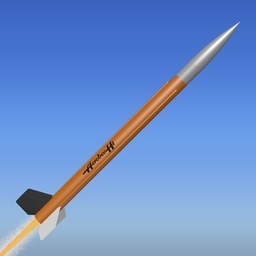   |
| Rating | |
| Length | 58.50" 148.59cm |
| Diameter | 3.10" 7.87cm |
| Weight | 2.13lbs 0.97kg |
| Parachute | |
| Drogue | |
| Motor Mount | 38mm |
| Deployment | Single |
Aerobee Hi-3"
File

 aerobeehi.pdf
aerobeehi.pdf Description
Features:
High Power Rocket
Heavy Duty Plastic Nose Cone
1/8" Plywood Laser Cut Fins
Delrin Rail Buttons
Dual Deployment Capable
Pre-slotted Airframe
Balsa Conduit Facade
9/16" Tubular Nylon Shock Cord
Specifications:
Length: 58.5"
Diameter 3.1"Ì´ååÌÎå«Ì´å
Weight: 34oz
Motor Mount: 38mm
Fins: 1/8"Ì´ååÌÎå«Ì´å Plywood
Optional Recovery System:
30" Quality Nylon Chute
9x9 Chute Protector
History:
The first major improvement of the basic Aerobee was the Aerobee-Hi, which was developed from late 1952 and first flew in 1955. It had a longer propellant tank, new materials in the rocket engine for higher efficiency, and larger fins for improved stability. Initially two different variants were built for USAF and U.S. Navy, the Air Force-Hi (which didn't use any formal designation, except for the general project designator MX-1961) and the RTV-N-13 (later RV-N-13) Navy-Hi. The Air Force-Hi could loft a payload of 68 kg (150 lb) to about 240 km (150 miles), while the slightly longer Navy-Hi could reach 270 km (170 miles). There were several different Aerobee-Hi sustainer engine configurations, known as AJ11-6, AJ11-18, AJ11-20, AJ11-21, AJ11-25 and AGVL-0113C/F/H/I. The variants of the Navy-Hi were designated RV-N-13a, RV-N-13b (with an AJ11-21 motor) and RV-N-13c. In 1959, the name Aerobee 150 was assigned by NASA to a "standarized" Aerobee-Hi, which was a slightly modified Air Force-Hi.















